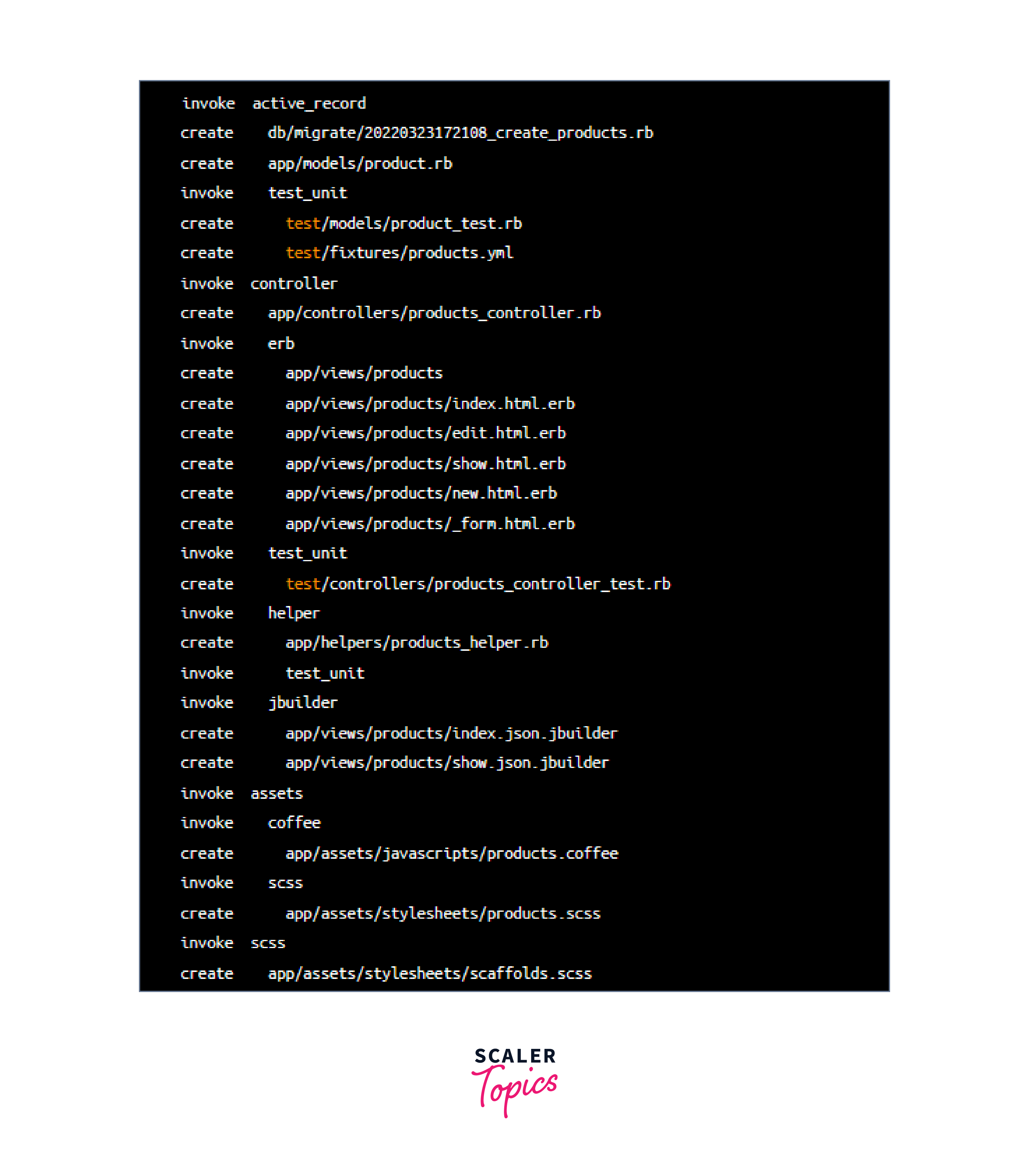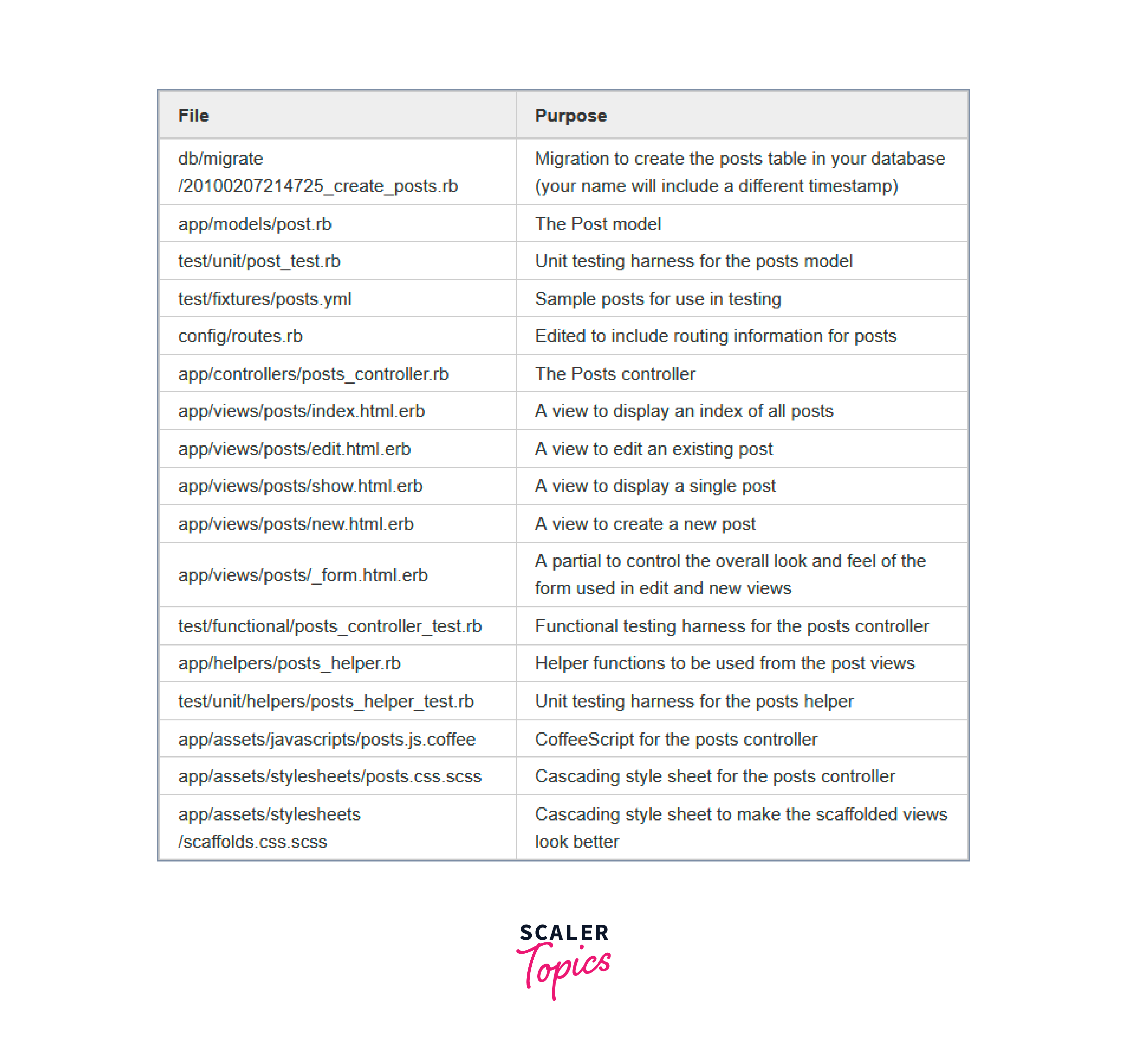Ruby on Rails:Scaffold Rails
Overview
When developing a rails application in Ruby on Rails, it is necessary to create numerous boilerplate files with their corresponding code. Also when adding a new feature to our application, executing CRUD (Create Read Update Delete) operations and establishing routes to every page makes it stressful and time-consuming. So, to address these challenges we can auto-generate the boilerplate code using the Rails scaffold command which we'll cover in this article.
What is Scaffolding?
Scaffolding is a tool in Ruby on Rails that automatically generates code for new resources like models, views, and controllers. It helps in quickly creating basic pieces of an application that can be modified later.
How to use the Rails Scaffold Command
- Open the terminal
- Navigate to the root directory of our Rails application
- Run the following command
Here, we need to replace ResourceName with the name of the resource to be created, and attribute1:type with the name and data type of the attribute to be included in the resource.
For example, to create a Product resource with name and price attributes, one can use the following command:
Now, rails will generate all the necessary code for the Product resource, including the model, view, and controller component and The generated code can be used to perform CRUD (Create, Read, Update, Delete) operations on the Product resource.
Run the migration to create the resource's database table by using the following command:
This will create the necessary table(s) in our database. The files generated by the 'scaffold' command are:
- Controller
- Model
- Views for every standard controller action (index, edit, show, new)
- A new route
- Migration to prepare our database

Scaffold Rails with Extra Fields
Now the above code will generate a boilerplate code for a model, view, and controller. But sometimes when using scaffolding, some extra fields may be needed in the model that is not included in the default scaffold. Default fields are the attributes of the table that are auto-generated timestamps, such as the created_at and updated_at fields. To add extra fields, we can simply add extra fields when generating the scaffold.
For example, to create a new Task resource with extra fields like description, title, and completed in addition to default fields like timestamps, one can use the following command:
The above command will generate a model with three attributes/fields:
- Title
- completed
- description
Now we may migrate the database to include the new fields, and also views and controllers will be updated to reflect the new fields.
Specific Component Generation
The Scaffold command generates code for all three components - model, view, and controller. But, sometimes only specific components for the resource needed to be generated. A specific component using scaffold can be generated by using the --no- option followed by the name of the component to be excluded.
For example, to generate a 'Post' model and view components, without the controller, one can use the following command:
The above command generates a Post model and view, without creating the controller component.
Creating an Empty Rails Web Application
To create an empty rails web application, open the terminal and navigate to the directory where the project will be created. Let's say we are in the required directory.
Now create an empty rails project by using the following command:
Replace mywebapp with the name of our application. The above command creates a new directory called mywebapp, which contains all the files and directories that are required for a new Rails application - basically an empty Rails project.
Now navigate to the newly created folder mywebapp which will contain the following file structure:

- Database Setting: Rails provide multiple environments such as development mode, test mode, or production mode, using different databases. We can edit the configuration file mywebapp\config\database.yml to let the rails application know the database of our application:
- Scaffolding Code Generation: Now we can create some boilerplate code using the rails scaffold command which will create all necessary resources and let us focus on the main requirements of our application:
This will generate the following files and will also edit routes for the post resource created:

- Controller Setup: Rails scaffold has already created the controller for post which consists of different methods like new, show, edit, and destroy for implementing the CRUD logic to our post page:
- Model Enhancement: Rails provide many error-handling options to help enhance the Model such as validations. The following validations can help the model take data according to the requirement without any chance of error:
- Another command for Creating Rails Scaffolding: We can create the boilerplate code with all the migrations, models, controllers, and also the routes with another command:
Here, g stands for 'generate'.
FAQs
Q: What is a Rails Scaffold?
A: Rails Scaffold is a code generator tool in Ruby on Rails that creates a set of standard views, controllers, and model files for a particular database table. It can save time and effort in creating basic CRUD functionality for an application.
Q: Are there any downsides to using a Rails Scaffold?
A: Rails Scaffold can save time and effort in creating basic CRUD functionality but it may not be suitable for more complex applications. As it may create some unnecessary files which can in turn complicate the file structure.
Q: Can we use a Rails Scaffold with an existing database?
A: Yes, we can use a Rails Scaffold with an existing database. Generate the scaffold with the same name as the existing database table, and ensure that the attributes match those in the database table.
Conclusion
- A Rails Scaffold is a code generator tool in Ruby on Rails that creates a set of standard views, controllers, and model files for a particular database table.
- The files generated by the 'scaffold' command are:
- Controller
- Model
- Views for every standard controller action (index, edit, show, new)
- A new route
- Migration to prepare our database
- A specific component using scaffold can be generated by using the --no- option followed by the name of the component to be excluded.
- Rails scaffold creates a controller which consists of different methods like new, show, edit, and destroy for implementing the CRUD logic to our page.
- We can add error handling like validations to adhere to the requirements of the application.
